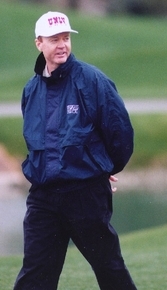Scoring format for NCAA golf championship benefits underdog, TV
It was tougher to win back in 1998. That’s not debatable. But like most college sports in this era of the Bowl Championship Series and now playoff football, the national championship for men’s golf is more about generating fan interest than fretting over what might be the most demanding test for its participants.
It’s all about the number of eyeballs watching.
How tough it is to sit atop a leaderboard is secondary.
Dwaine Knight knows this well, meaning he realizes the opportunity to win a title for 30 teams that advance to nationals is larger than when he led the Rebels to the championship 17 years ago.
You couldn’t have many awful holes and claim anything back then.
You can now. More than a few, even.
More than a few shanks and bogeys.
“It’s like the 3-point shot in basketball,” Knight said. “This scoring format gives a team that might not be thought good enough a chance to knock off the best. I’m biased, obviously, but I like how it was before. But this does bring television more into the action, and people get excited about it. Fans understand this system better. They understand a head-to-head concept. It makes sense to them.”
He continues to be the best coach that strolls UNLV’s campus daily, about to bring the Rebels to a 19th national tournament in 28 years under his guidance. Knight and his team have advanced to the Concession Golf Club outside Bradenton, Fla., where a champion will emerge from play from May 29 to June 3.
It has been a goal since the end of last season, to play the course designed by Jack Nicklaus and one that offers spectacular views over 520 acres. The Rebels have studied every detail of it, from the yardage book to wind patterns to the greens to the type of grass they will stroll.
This is their annual ritual, to become as familiar as possible with the place a national champion will be crowned.
It is where the NCAA will again stage 54 holes of stroke play that will determine which eight teams advance to a seeded match play, which groups of five will enter the quarterfinals of a bracket.
Elite Eight. Final Four. National Championship.
It’s May/June Madness on the links.
The switch in 2009 to match play deciding the champion has not come without debate, given the team considered best nationally has yet to win the title under the new scoring system.
Oklahoma State is the gold standard for men’s golf, having made nationals 65 straight years. It led the field by 13 shots after stroke play in 2009 and was also the country’s premier team and No. 1 seed in 2010.
It was upset in match play both times.
You will hear arguments on both sides as to whether the format has created the sort of drama and intrigue those at the NCAA sought when changing the scoring system for the first time in 44 years.
The match play portion again will be shown live on Golf Channel, and it’s true unpredictable results — of the past six champions, two No. 7 seeds and a No. 6 have been among those standing last — have defined recent finals.
It’s the only way Augusta State could have won titles in 2010 and 2011, the first repeat champion since Houston in the mid-1980s.
But it’s not the purest way to crown anything and has, in fact, taken somewhat of the shine off the individual champion as he claims a title on one hole while teams fight their way into the Elite Eight on others.
Fact: Some golfers advance to nationals having never competed in match play.
Like, ever.
It’s also not the manner in which college golf is contested throughout the season, and to believe you will draw a much larger audience simply because Alabama might be meeting Ohio State or UNLV is about to take on Texas is presumptuous at best.
It’s still college golf. It means the most to those involved and friends and family members that support them. Last year’s match play averaged 250,000 viewers on Golf Channel and reached 2.2 million over the course of nationals, which could suggest the head-to-head format has at least piqued a small amount of mainstream interest. Or not.
“When we won the (championship in 1998), every shot you took was significant,” Knight said. “We had a 10-shot lead against Clemson with nine holes to go, and by the 16th, we were dead even. We had given up the entire lead. But then we played the final three holes really well and won. That was hard.
“We’ve also seen the other side of it with match play, when (in 2013) we met Georgia Tech in the Elite Eight. We’re even after 18 holes and lost in sudden death. So you can come close and not win and it can be gut-wrenching, or you can get the job done and it is exhilarating.
“But there is still nothing like this time of year. I still get a kick out of it. I still get a lot of enjoyment out of watching our young guys compete.”
There is better opportunity to win it all now, to be Augusta State.
That is a wonderful feeling ... unless you’re Oklahoma State and leading by 13 shots after 54 holes.
It’s all about TV and eyeballs now.
Isn’t everything?
Las Vegas Review-Journal sports columnist Ed Graney can be reached at egraney@reviewjournal.com or 702-383-4618. He can be a heard on “Seat and Ed” on KRLV 1340 from 2 p.m. to 4 p.m. Monday through Friday. Follow him on Twitter: @edgraney.

























